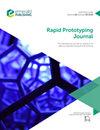通过选择性激光熔融技术制造的原位 TiC 增强 Ti6Al4V 基复合材料
IF 3.6
4区 工程技术
Q1 ENGINEERING, MECHANICAL
引用次数: 0
摘要
目的目前用于制备选择性激光熔融 (SLM) 复合粉末原料的方法依赖于成本高昂的纳米颗粒或产生不一致的粉末形态。本研究旨在开发一种具有成本效益的 Ti6Al4V-碳原料,它能保持母体 Ti6Al4V 颗粒的流动性,并生产出具有优异特性的原位 TiC 增强 Ti6Al4V 复合材料。这种复合粉末原料被用于利用各种能量密度制造原位 TiC-Ti6Al4V 复合材料。针对不同的 SLM 加工参数,对复合材料的相对孔隙率、微观结构和硬度进行了评估。经过 SLM 加工后,原位生长的 100-500 nm 尺寸的 TiC 纳米颗粒分布在 α-马氏体 Ti6Al4V 基体中。TiC 颗粒的形成细化了 Ti6Al4V β 晶粒尺寸。根据加工参数的不同,相对密度在 96.4% 到 99.5% 之间变化。孵化距离、曝光时间和点距离都对相对孔隙率变化有效,而只有曝光时间和点距离对硬度变化有效。本研究获得的原位 SLM 复合材料具有较高的相对密度值、分散良好的 TiC 纳米颗粒和更高的硬度。此外,在未来的研究中,该原料制备方法还可适用于各种基体和增强材料。本文章由计算机程序翻译,如有差异,请以英文原文为准。
In situ TiC reinforced Ti6Al4V matrix composites manufactured via selective laser melting
Purpose
Current methods for the preparation of composite powder feedstock for selective laser melting (SLM) rely on costly nanoparticles or yield inconsistent powder morphology. This study aims to develop a cost-effective Ti6Al4V-carbon feedstock, which preserves the parent Ti6Al4V particle’s flowability, and produces in situ TiC-reinforced Ti6Al4V composites with superior traits.
Design/methodology/approach
Ti6Al4V particles were directly mixed with graphite flakes in a planetary ball mill. This composite powder feedstock was used to manufacture in situ TiC-Ti6Al4V composites using various energy densities. Relative porosity, microstructure and hardness of the composites were evaluated for different SLM processing parameters.
Findings
Homogeneously carbon-coated Ti6Al4V particles were produced by direct mixing. After SLM processing, in situ grown 100–500 nm size TiC nanoparticles were distributed within the α-martensite Ti6Al4V matrix. The formation of TiC particles refines the Ti6Al4V β grain size. Relative density varied between 96.4% and 99.5% depending on the processing parameters. Hatch distance, exposure time and point distance were all effective on relative porosity change, whereas only exposure time and point distance were effective on hardness change.
Originality/value
This work introduces a novel, cost-effective powder feedstock preparation method for SLM manufacture of Ti6Al4V-TiC composites. The in situ SLM composites achieved in this study have high relative density values, well-dispersed TiC nanoparticles and increased hardness. In addition, the feedstock preparation method can be readily adapted for various matrix and reinforcement materials in future studies.
求助全文
通过发布文献求助,成功后即可免费获取论文全文。
去求助
来源期刊

Rapid Prototyping Journal
工程技术-材料科学:综合
CiteScore
8.30
自引率
10.30%
发文量
137
审稿时长
4.6 months
期刊介绍:
Rapid Prototyping Journal concentrates on development in a manufacturing environment but covers applications in other areas, such as medicine and construction. All papers published in this field are scattered over a wide range of international publications, none of which actually specializes in this particular discipline, this journal is a vital resource for anyone involved in additive manufacturing. It draws together important refereed papers on all aspects of AM from distinguished sources all over the world, to give a truly international perspective on this dynamic and exciting area.
-Benchmarking – certification and qualification in AM-
Mass customisation in AM-
Design for AM-
Materials aspects-
Reviews of processes/applications-
CAD and other software aspects-
Enhancement of existing processes-
Integration with design process-
Management implications-
New AM processes-
Novel applications of AM parts-
AM for tooling-
Medical applications-
Reverse engineering in relation to AM-
Additive & Subtractive hybrid manufacturing-
Industrialisation
 求助内容:
求助内容: 应助结果提醒方式:
应助结果提醒方式:


